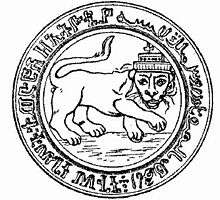Negus
Negus (Ge'ez: ንጉሥ, nəgueś ; cf. Tigrinya: ነጋሲ negus) is a royal title in the Eritrean and northern Ethiopia Semitic languages.[1] It denotes a monarch,[2] such as the Bahri Negasi (king of the sea) of the Medri Bahri kingdom in pre-1890 Eritrea, and the negus in pre-1974 Ethiopia. The negus is referred to as An-Najashi (النجاشي) in the Islamic tradition.

Overview
Negus is a noun derived from the Eritrean and northern ethiopia Semitic root ngś, meaning "to reign". The title has subsequently been used to translate the words "king" or "emperor" in Biblical and other literature. In more recent times, it was used as an honorific title bestowed on governors of the most important provinces (kingdoms): Gojjam, Begemder, Wollo, Tigray and the seaward kingdom (where the variation Bahri Negasi "King of the Sea", was the ancient title of the ruler of present-day central Eritrea) and later Shewa.[3][4]
Both uses and the imperial dignity would meet in the person of a regional prince, Lij Kassa Hailu, the third youngest son of Däjazmač Hailu Wolde-Giyorgis, Governor of Qwara Province, by his second wife Woizero Attitaggab. He rebelled against Empress Menen and her son, the Viceroy Ras Ali II of Yejju, in 1845 and spent the next nine years alternating between rebellion and submission until he was proclaimed negus at Amba Chera on 19 September 1854, and after the Battle of Derasge proclaimed himself emperor on 8 February 1855 and was crowned as Tewodros II, at Derasge Maryam the next day.
References
- Haile Selassie, Western Education, and Political Revolution in Ethiopia. Cambria Press. ISBN 9781621969143.
- Negus. Amharic nəgus, from Geez nĕgūša nagašt king of kings. First Known Use: 1594 Merriam Webster dictionary
- Mussie Tesfagiorgis G. Ph.D. (29 October 2010). Eritrea. ABC-CLIO. pp. 34–35. ISBN 978-1-59884-232-6.
- Alemseged Abbay (1998). Identity Jilted, Or, Re-imagining Identity?: The Divergent Paths of the Eritrean and Tigrayan Nationalist Struggles. The Red Sea Press. p. 202. ISBN 978-1-56902-072-2.